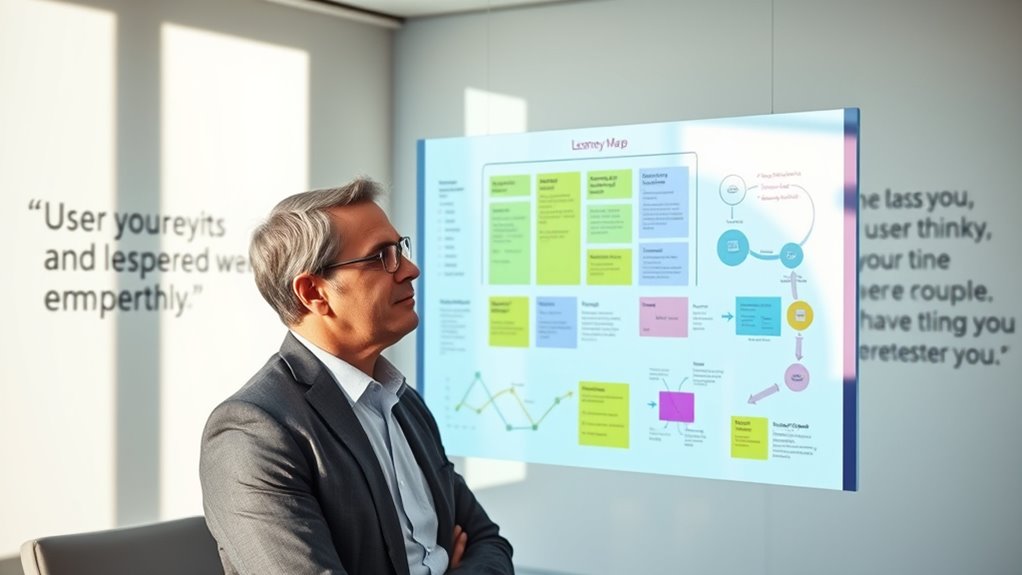As an empathetic CEO, you rewire decision-making by focusing on user needs, fostering trust, and encouraging collaboration. By adopting a design mindset, you prioritize understanding diverse perspectives, which boosts innovation and resilience. Embracing empathy helps you navigate complex challenges with creative solutions, turning obstacles into opportunities for growth. If you want to discover how cultivating these mindsets can transform your leadership approach, you’ll find valuable insights ahead.
Key Takeaways
- Empathetic CEOs leverage user-centric insights to make decisions that prioritize customer needs and foster trust.
- Design mindsets encourage reframing challenges creatively, leading to innovative, inclusive solutions in executive choices.
- Applying empathy enhances stakeholder engagement, improving collaboration and consensus during complex decision processes.
- Emotional intelligence and active listening enable CEOs to understand diverse perspectives, reducing conflicts and guiding effective actions.
- Measuring organizational resilience through design thinking practices helps empathetic leaders adapt swiftly in uncertain environments.
Embracing User-Centric Perspectives in Leadership

To truly lead with empathy, you need to prioritize understanding your users’ needs and experiences. Emotional intelligence helps you recognize and interpret their feelings, creating a foundation for genuine connection. By adopting a user-centric perspective, you can better anticipate challenges and discover innovative solutions. Creative problem solving becomes essential, allowing you to approach obstacles with fresh ideas rooted in empathy. When you put yourself in your users’ shoes, you gain insights that drive meaningful improvements and foster trust. This approach not only enhances product development but also shapes your leadership style, making you more adaptable and responsive. Establishing healthy boundaries and engaging in regular check-ins can support ongoing relationship building, ensuring trust and understanding are maintained. Ultimately, embracing user perspectives enables you to lead with authenticity, aligning your decisions with what truly matters to those you serve.
Cultivating Empathy to Drive Organizational Change

Cultivating empathy within your organization transforms change from a top-down directive into a shared, motivated effort. By fostering emotional intelligence, you create an environment where team members feel understood and valued, which enhances collaboration. Empathy helps you recognize diverse perspectives, making conflict resolution more effective and less confrontational. When leaders demonstrate genuine concern and active listening, employees are more likely to engage willingly in organizational change. Building this empathy requires intentional communication and openness to feedback, ensuring everyone’s voice is heard. Incorporating water-based approaches to well-being can support stress relief and emotional resilience among staff. As a result, you cultivate trust and buy-in, making change initiatives smoother and more sustainable. Ultimately, empathetic leadership aligns your organization around common goals, empowering everyone to navigate change with confidence and understanding.
Applying Design Thinking to Complex Decision-Making

Empathy cultivated through strong leadership serves as a foundation for applying design thinking to complex decision-making. When you approach challenges with an empathetic mindset, you gain access to creative problem solving that considers diverse perspectives. Using innovative storytelling, you can connect with stakeholders’ needs and craft compelling narratives that clarify options and drive consensus. Design thinking encourages you to reframe problems, explore multiple solutions, and prototype ideas quickly, making decisions more adaptable and user-centered. By focusing on empathy, you’re better equipped to navigate ambiguity and uncover innovative solutions rooted in real human experiences. Incorporating cultural narratives helps leaders better understand the diverse backgrounds and values of their teams, fostering more inclusive and effective decision-making. This approach transforms complex decisions from intimidating obstacles into opportunities for strategic growth, fostering a culture that values creative problem solving and continuous learning.
Building Collaborative Cultures Through Empathetic Practices

Building a collaborative culture begins with leaders modeling empathetic practices that encourage openness and trust. You demonstrate emotional intelligence by recognizing and validating your team’s feelings, fostering a safe environment for honest dialogue. Practice active listening by giving your full attention, asking clarifying questions, and refraining from interrupting. When team members feel heard and understood, they’re more likely to share ideas and concerns freely. Transparency and genuine curiosity create a sense of mutual respect, strengthening relationships across the organization. As an empathetic leader, you set the tone for others to follow, cultivating an atmosphere where collaboration thrives. This approach not only improves communication but also builds resilience, innovation, and a shared sense of purpose crucial for long-term success. Recognizing empathy as a core leadership trait can significantly enhance team cohesion and performance.
Measuring Impact: How Design Mindsets Enhance Business Resilience

Understanding how design mindsets influence business resilience requires clear measurement of their impact. You can evaluate this by evaluating improvements in emotional intelligence, which enhances leaders’ ability to empathize and adapt during crises. Strong stakeholder engagement is another key indicator, showing how well you foster relationships that support long-term stability. Implementing privacy policies and transparent data practices can also strengthen stakeholder trust, further enhancing resilience. Measure metrics that track changes in decision-making agility, customer loyalty, and employee morale—areas directly affected by empathetic leadership. Conduct surveys and feedback loops to quantify shifts in organizational resilience. By linking these measures to specific design mindset practices, you gain insight into how empathy and stakeholder focus bolster your company’s capacity to navigate uncertainties. Ultimately, precise measurement reveals the transformative power of design mindsets on your business’s resilience.
Frequently Asked Questions
How Can CEOS Develop Empathy Without Losing Strategic Focus?
You can develop empathy without losing strategic focus by integrating strategic empathy into your leadership. Measure empathy through tools like empathy assessments and feedback, ensuring genuine understanding. Prioritize active listening and put yourself in others’ shoes to foster connection. Balancing empathy measurement with clear goals helps you stay aligned with your vision. This approach enables you to lead with compassion while maintaining the strategic clarity needed for impactful decisions.
What Training Methods Best Foster Design Thinking in Executive Teams?
Did you know 85% of innovative companies use hands-on training to foster design thinking? To develop this mindset in your executive team, engage them in innovative workshops that encourage real-world problem solving. Pair this with mentorship programs where experienced leaders guide others through design thinking principles. These methods actively build empathy and creativity, ensuring your team stays strategic while embracing user-centric approaches.
How Do Empathetic Practices Influence Long-Term Company Culture?
Empathetic practices strengthen your company’s long-term culture by fostering organizational cohesion and boosting employee retention. When you prioritize understanding your team’s perspectives, you create an environment where trust and collaboration thrive. This approach encourages open communication, making employees feel valued and understood. Over time, these practices build a resilient, connected culture that attracts and retains top talent, ensuring sustained success and a positive workplace atmosphere.
Can Design Mindsets Be Adapted for Crisis Management Situations?
You can adapt design thinking for crisis management by focusing on empathy, rapid prototyping, and iterative solutions. This approach boosts crisis resilience, helping you understand stakeholder needs quickly and develop flexible strategies. By embracing a mindset of experimentation, you can navigate uncertainty more effectively, making informed decisions under pressure. Applying design thinking in crises guarantees you stay responsive, innovative, and prepared to handle evolving challenges with agility.
What Role Does Emotional Intelligence Play in Empathetic Leadership?
Imagine you’re leading a team through a tough project. Your emotional intelligence helps you recognize your team’s stress, showing emotional awareness. You then use relationship management to listen and respond empathetically, boosting morale. This connection fosters trust and collaboration. Emotional intelligence, especially emotional awareness and relationship management, enables empathetic leadership by helping you understand others’ feelings and build strong, supportive relationships that drive success.
Conclusion
Imagine steering a ship through turbulent waters—you need to understand your crew’s needs and adapt quickly. By embracing design mindsets, you’ll foster empathy and collaboration, transforming challenges into opportunities. Studies show that empathetic leaders see a 20% boost in team performance. Just like a skilled captain navigates with intuition and insight, you can rewire decision-making to create resilient, innovative organizations that thrive amid change.









